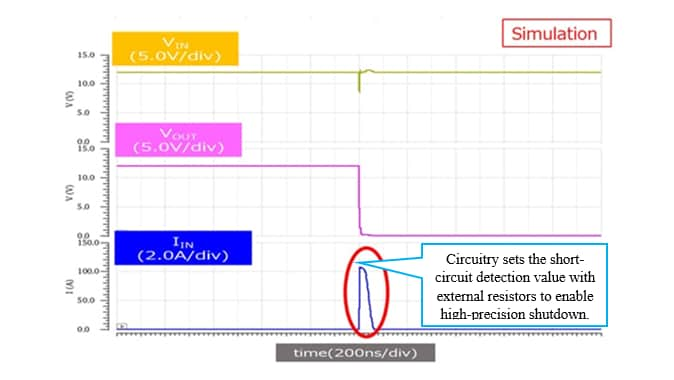- 半導體首頁
-
應用Automotive
Body Electronics
xEV
In-Vehicle Infotainment
Advanced Driver-Assistance Systems (ADAS)
Chassis
IndustrialInfrastructure
BEMS/HEMS
Factory Automation
Commercial Equipment
Consumer/PersonalIoT Equipment
Healthcare
Wearable Device
Mobile
Computer Peripherals
-
產品車用元件
Discrete Semiconductor
Diodes
電晶體
通用邏輯IC
Analog Devices
Digital Devices
Wireless Devices
※
: Products list (parametric search)
功率半導體※
: Products list (parametric search)
隔離器/固態繼電器Photocouplers
Digital Isolators
※
: Products list (parametric search)
MOSFETsIGBTs/IEGTs雙極性電晶體※
: Products list (parametric search)
Diodes※
: Products list (parametric search)
微控制器馬達驅動 ICs智能功率 ICs※
: Products list (parametric search)
電源管理 ICs線性 ICs※
: Products list (parametric search)
通用邏輯 ICs線性影像感測器其他產品其他產品
※
: Products list (parametric search)
-
開發/設計支援
開發 / 設計支援
-
技術知識
- 購買管道
- 型號 & 關鍵字搜尋
- 交叉搜尋
- 參數搜尋
- 線上庫存查詢跟購買
This webpage doesn't work with Internet Explorer. Please use the latest version of Google Chrome, Microsoft Edge, Mozilla Firefox or Safari.
型號需要超過三個文字以上 Search for multiple part numbers fromhere.
The information presented in this cross reference is based on TOSHIBA's selection criteria and should be treated as a suggestion only. Please carefully review the latest versions of all relevant information on the TOSHIBA products, including without limitation data sheets and validate all operating parameters of the TOSHIBA products to ensure that the suggested TOSHIBA products are truly compatible with your design and application.Please note that this cross reference is based on TOSHIBA's estimate of compatibility with other manufacturers' products, based on other manufacturers' published data, at the time the data was collected.TOSHIBA is not responsible for any incorrect or incomplete information. Information is subject to change at any time without notice.
型號需要超過三個文字以上
The fuse electronization changes the design?
Conventional fuses and poly switches, which use heat generation to shut down or limit overcurrent, are susceptible to ambient temperature and operating conditions, and it is difficult to set the operating current with high accuracy. Therefore, they may operate at an unintentional current to cause abnormal system operation. In the case of a fuse that uses blowing, there is also the disadvantage that parts need to be replaced.
On the other hand, electronic fuses (eFuse IC) are a solution to these issues. eFuse IC utilizes semiconductor-based integrated circuits to provide not only a simple shut down function but also a variety of built-in protective functions. Main features are short-circuit protection, overvoltage clamping (OVP) [Note 1], overcurrent clamping (OCP) [Note 1], overheat protection, inrush current suppression, reverse current prevention, etc., and conformity to the component standards of the safety standard IEC62368-1 for IT/AV equipment.
This article introduces the current setting of short-circuit as basic function of fuse and overcurrent clamping.
[Note 1] OCP : Over Current Protection OVP : Over Voltage Protection
Comparison of various fuses
Electronic fuse Toshiba eFuse IC |
Resettable fuse (poly switch) |
Chip fuse |
Glass fuse |
|
|---|---|---|---|---|
Protection method |
Shut down by MOSFET switch |
Current limit by resistance increase |
Blown conductive part |
Blown conductive part |
Protection speed |
150ns (Typ.) |
Several hundred ms to several seconds |
Several seconds |
Several seconds |
Repeated use |
Possible |
Possible |
Not possible |
Not possible |
Providing high-precision short-circuit protection

The figure below shows a simulated waveform when TCKE812 is supplying power of 12V and the output voltage is shorted steeply. Since the short-circuit detection current of eFuse IC is set by an external resistor, the detection current can be set with higher accuracy than a conventional fuse that uses heat generation.
When current flow reach at the short-circuit detection value, eFuse IC judges the short-circuit state (this state is also called as Fast Trip or Short Trip) and shut down the output current.
High-precision overcurrent clamping function

The overcurrent clamping function clamps (holds) the output current so as not to exceed the clamping limit value when the output current increases due to a load abnormality or short-circuit, etc., and protects against deterioration or destruction caused by heat generation of the device itself as well as preventing instantaneous power-off.
The clamping limit value is 62.5% of the short-circuit detection value. The optimum settings can be set according to the system. A robust design can be achieved by having a double overcurrent protection function in conjunction with a short-circuit protection function that operates when the output current exceeds the limit value significantly in a very short period of time.
TCKE8xx series can be clamped from low temperature to high temperature with high accuracy, and its accuracy is ±11%. This accuracy improves the degree of freedom in designing/selecting the components to be mounted. In addition, when the load at the subsequent stage fluctuates, the normal overcurrent protection function (circuit break) stops the output current immediately when the current reaches overcurrent limit value, and the output voltage drops.
On the other hand, eFuse IC clamps the current so that the current does not exceed the limit, so that a more stable power supply can be configured by keeping the output voltage within the withstand voltage of the subsequent IC while keeping the output voltage.
Recommended product list
Product Number |
|||||||
|---|---|---|---|---|---|---|---|
Data sheet |
|||||||
Stock check |
|||||||
Over voltage clamp VOVC Typ. (V) |
- |
6.04 |
15.1 |
||||
Recovery operation type |
Auto-retry |
Latch |
Auto-retry |
Latch |
Auto-retry |
Latch |
|
Package |
Name |
||||||
Size Typ. (mm) |
3.00×3.00, t=0.75 Max |
||||||
Operating ranges |
Input voltage VIN (V) |
4.4 to 18 |
|||||
Output current IOUT (A) |
0 to 5.0 |
||||||
Over current limit accuracy (%) |
±11 @Ta= -40 to 85℃、ILIM=4.38A |
||||||
On-resistance RON Typ. (mΩ) |
28 |
||||||

